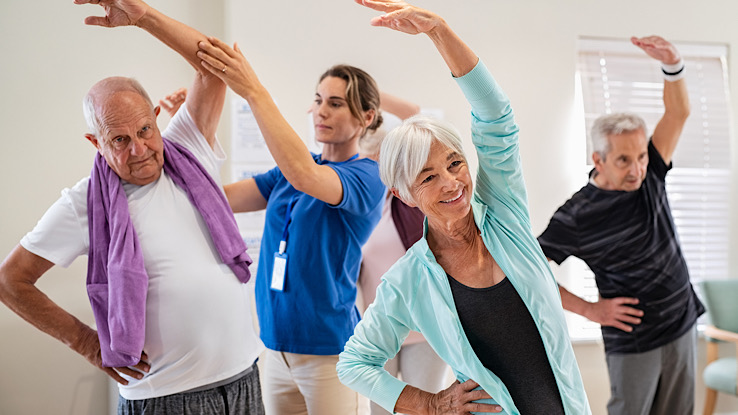
Older adults have to take special precautions when it comes to getting exercise. However, the benefits of physical activity at this age may outweigh the possible risks. This article will explore the many benefits of physical activity for older adults and any special precautions they need to take.
Physical Benefits of Physical Activity
Perhaps the most important reason to stay physically active as an older adult is to improve or maintain your overall health. It doesn’t matter if you were active before or just starting to exercise more. It’s never too late to start getting more physically active. Older Americans experience more significant physical benefits than younger people by becoming more active.
The following are some of the critical physical benefits of physical activity for older adults:
- Management of health conditions: Many health conditions, including high blood pressure, elevated cholesterol, and diabetes, can be better managed when an older adult is physically active.
- Reduced risk of chronic disease: When an older adult exercises regularly, it reduces the risk of developing chronic health conditions, such as heart disease, obesity, and colon cancer.
- Weight management: Obesity and being overweight are common health threats among older adults. Staying physically active decreases the risk of becoming overweight or obese. It can also help those with weight issues to get to a healthy weight.
- Better function in arthritis patients: Many older people have arthritis, and staying physically active can help to improve their overall joint function.
- Injury prevention: Older adults who exercise regularly are less likely to have injuries due to falls or other accidents.
Psychological Benefits of Physical Activity
One of the added benefits of being physically active at an older age is that it promotes overall psychological well-being. This is one aspect of exercise at an older age that many overlook. The key reason for this is that it helps improve an older individual’s independence, which can significantly improve their mood, outlook, and self-esteem. Those who exercise regularly at this age are more likely to remain independent and overcome health issues.
Similarly, regular physical activity for older adults has been linked to reduced feelings of depression and anxiety. As a person increases the amount of exercise they get, they are less likely to have these psychological challenges.
Social Benefits of Physical Activity
Some older adults who aren’t physically active end up spending much time alone at home. This can harm their health since it may lead to decreased mental stimulation. Older people who stay physically active often have a healthier social life that involves regular interaction with others and mental stimulation. In addition, a significant benefit of staying active as an older adult is that it can substantially reduce health care costs.
Best Physical Activities For Older Adults
There are lots of exercise options for older adults who want to be physically active. It’s essential to consider individual health concerns when choosing an exercise strategy for an older person. For example, someone with arthritis should find low-impact exercises that can benefit their health to put less pressure on their joints.
The following are some of the best types of physical activity for older adults:
- Tai Chi: This ancient martial art has been lauded as one of the best exercises for older people since it focuses on both the mind and the body. It is excellent for muscle coordination and mental clarity.
- Balance exercises: Any exercise which incorporates balance, such as dance, cycling, or tai chi, is excellent for older individuals since it helps to reduce the risk of falls.
- Cardio: Light- to moderate-intensity cardio workouts like brisk walking, cycling, swimming, or cross-country skiing are great for improving heart health.
- Low-impact exercises: Incorporating low-impact exercises reduces pressure on the joints. Examples include swimming, water aerobics, or using an elliptical machine.
- Physical activity: Older individuals can also incorporate regular physical activity in addition to exercise. Things like gardening, walking the dog, and raking the yard are all helpful for keeping elderly individuals active.
Precautions
Older adults can consider the following to ensure that their physical activities are safe and that they don’t cause further health problems or increase the risk of injury:
- Talk to your doctor about what exercise is best for you.
- Start slowly if you’re not used to physical activity, and gradually increase the intensity and length of your exercise.
- Wait at least 2 hours after eating a large meal to start exercising.
- Wear appropriate shoes for the activity. Please make sure they are comfortable and provide adequate support.
- Warm up with low-intensity activity and some light stretching before exercising.
- Stop immediately if you feel faint, dizzy, get muscle cramps, break out in a cold sweat, or feel severe pain in any part of your body. If these symptoms don’t subside, get medical attention.
Remember that for older adults, physical activity doesn’t have to involve an intense workout to get the health benefits. Older individuals only need to get a moderate amount of activity (such as 30 minutes of brisk walking) five times a week to improve their overall health.
Resource Links:
- “Physical Activity in Older Persons” via Missouri Medicine
- “The Importance of Physical Activity Exercise among Older People” via BioMed Research International
- “The association between social support and physical activity in older adults: a systematic review” via International Journal of Behaviorial Nutrition and Physical Activity
- “Physical activity is medicine for older adults” via Postgraduate Medical Journal
- “Physical activity in older age: perspectives for healthy ageing and frailty” via Biogerontology





